How To Find Market Share Percentage
When the US court dismisses what was expected to be a tech game-changing lawsuit on the grounds that attorneys failed to prove Facebook's monopolistic status and show its market share, it becomes clear that market share questions can be quite challenging to address in the online realm.
Whether you are running market research, considering new growth strategies or want to simply find benchmarks for performance assessment, market share is one of the most important metrics to consider.
With giant brands — think P&G, Coca-Cola, or Tesla — large analytics firms publish annual reports that track their market share shifts.
But if you aren't operating on that scale, and especially if you have an online business, there are other ways to calculate market share without involving expensive and often lagging third-party analytics.
This post will walk you through all the essentials of market share assessment and highlight some of the top market share growth tactics.
In the traditional sense, market share is always about sales.
So, if you Googled "market share definition", you'd get something like this:
"Market share is the percent of total sales in an industry generated by a particular company." — Investopedia
Essentially, if you're operating in a billion-dollar market, and your annual revenue is at $100,000,000, you have a 10% market share.
In the online space, however, it may not just be about sales. Say, in Facebook's example (this is what the court highlighted as a point for criticism), the main service they provide — social networking — is actually free. The advertising dollars they receive are a part of a different, online advertising, market.
Hence, with online businesses, you can also take active users, traffic, and other criteria into account instead of just considering sales.
Whatever criteria you use, it's important to keep in mind that market share is never a constant number. It's prone to change, so if anyone's talking about market share, they tend to imply specific time periods — quarterly or annual stats.
There are a few popular ways to calculate market share:
- The classical market share formula is based on the industry's total sales.
- The customer market share formula is customer-centric, so you have to know the total number of customers within your market.
- The relative market share formula is based on the market shares of your industry's key players.
In the online realm, however, sales and customers can be easily replaced by traffic, as the former numbers can be difficult to grasp unless you're dealing with a market full of public companies.
Find your company's total sales for a preferred period, and divide that number by the industry's total revenue during the same period; then multiply the number by 100 to get a percentage amount.
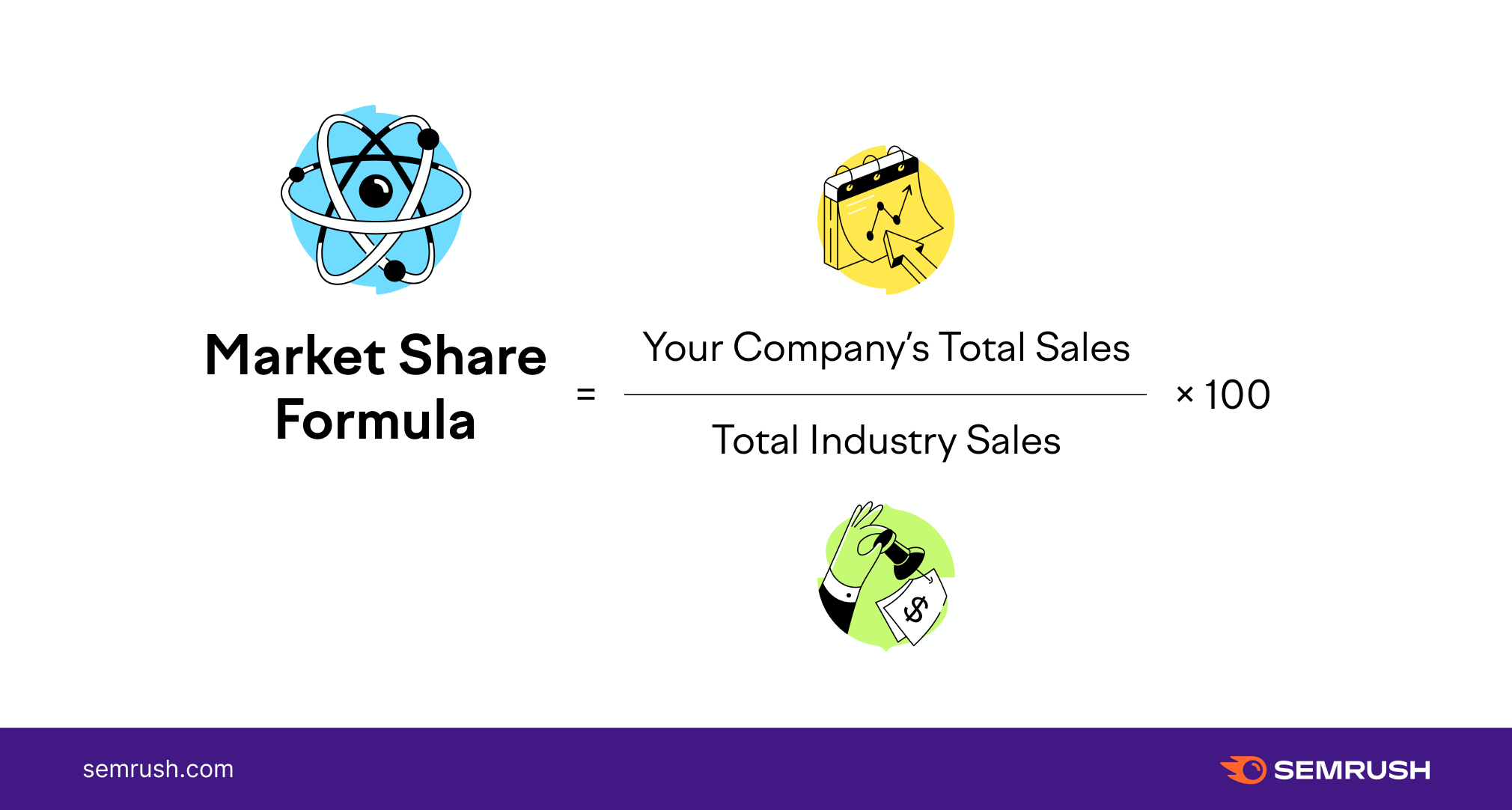
For instance, if you sell shoes and your total sales for a quarter equaled $100,000 and for that same time, total industry sales were $1,000,000, your market share is 10%.
The exact formula would look like this:
$100,000 / $1,000,000 = 0.10 x 100 = 10% market share.
This metric will give you an overall understanding of your company's position within the industry. However, try to compare yourself against direct competitors. Otherwise, this won't be a valuable metric for you to track.
In some cases, you might measure market share by the number of customers instead. This is usually the preferred method for more prominent industries, which tend to have these figures readily available.
In this case, you trade sales for customers to get a similar percentage amount.
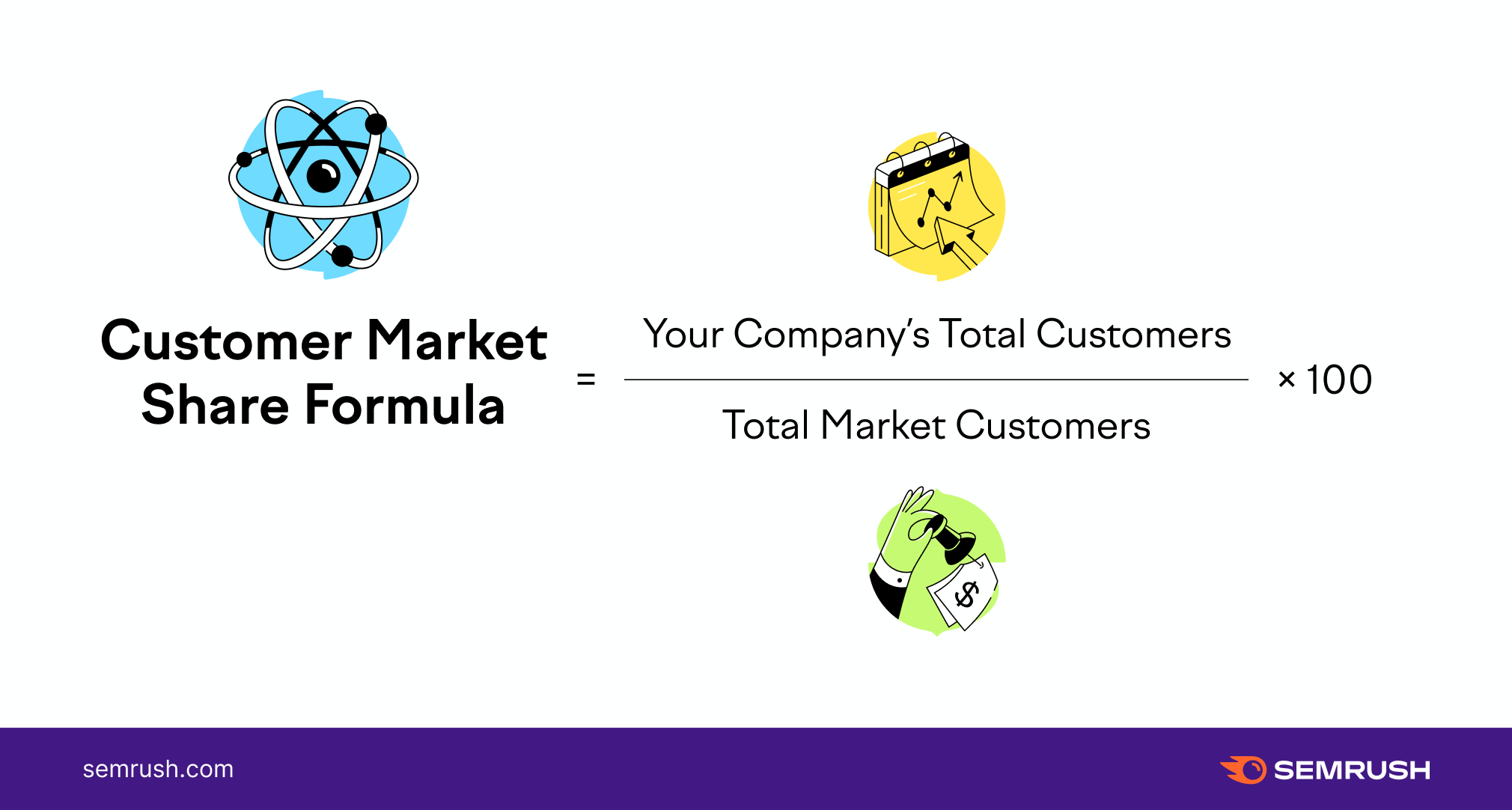
Keeping our shoe company example, say you have 50,000 customers during that same quarter. The business is located in an area where there are 1,000,000 shoe customers during that same period.
So, the formula would look like: 50,000 / 1,000,000 = 0.05 x 100 = 5%
Another way is to compare your performance to industry leaders. Here, you divide your market share by your top industry competitor's market share. Then, multiply this result by 100 to get a percentage amount.
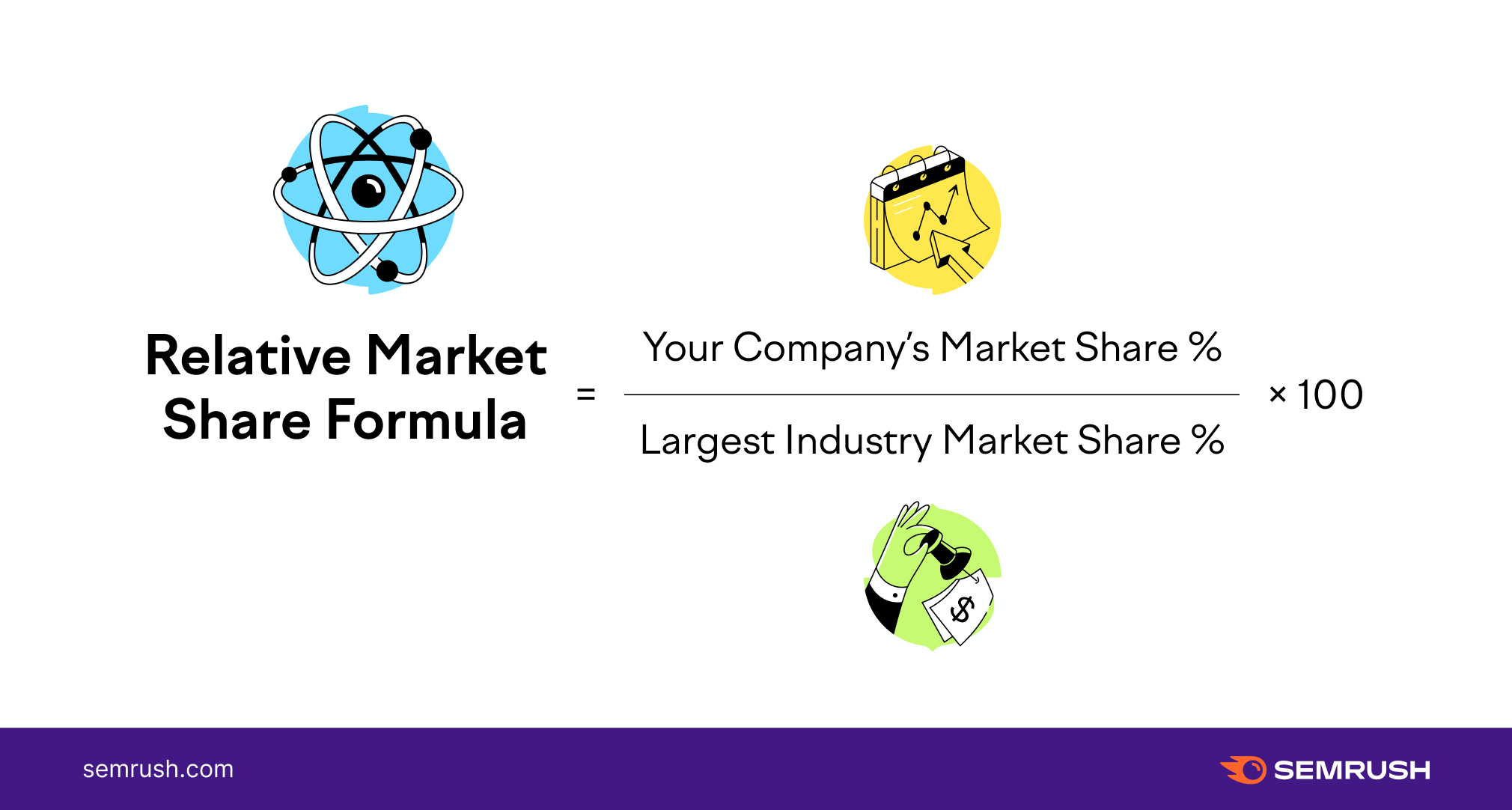
Using the previous example, let's say the largest direct competitor has a 45% market share. Then, your relative market share formula would look like this:
10% / 45% = 0.22 x 100 = 22% relative market share.
The result is your portion of the market in relation to your largest competitor. This metric could serve as a more accurate representation of your business's financial state.
In itself, market share is just a number. To get an action plan out of this number, you have to find ways to analyze and apply it.
While market share formulas can shed some light on how you should go about your business assessment, you have to take a more granular approach to get an accurate view of your business performance; otherwise, you might end up comparing your local pastry brand against the global pastry market, which would be misleading.
Here are a few things to do before you jump to conclusions:
- Define your target: Market share is usually calculated per country. Drilling down into your target market helps you discover where your potential customers live and compare regions.
- Compare yourself against similar businesses: Choose similar-sized companies that share your audience demographics to evaluate your market share better and understand your market share's impact.
- Explore competitors' market share: In one market, a 10% market share can imply market leadership; in others, it means an average performance. To be able to run business assessment, you need to take a comparative view and stack your market share numbers up against the competition.
- Look for gaps and opportunities: Using the Custom Market Dynamics section of your Market Explorer report, you can analyze the strategies of other market players. This can help you benefit from the tactics market leaders use to see if you can implement them. When you notice sharp increases, see what companies are doing using Traffic Analytics, Organic Research, Advertising Research, and Social Media Tracker to fine-tune your strategies.
Of course, you can go through industry reports and try to dig out industry revenue, customer, and market share stats from across the web, but they're unlikely to be as current or relevant as you need them to be.
In the online realm, market share can (and should) be calculated based on traffic numbers, and in this case, you can use Semrush Market Explorer's intel, which will do all the dirty work we talked about in the previous section:
- Assess your site's market share in regard to various markets (you can specify the geographical location);
- Select the closest competitors based on organic traffic counts and target audiences;
- Get estimates on competitors' market share to benchmark and evaluate your online performance.
While Market Explorer is a goldmine of insights for all things market research, let's imagine Warby Parker, a NY-based eyewear brand that operates both online and offline, wanted to assess its online market share.
Here are the key market share related insights you can gather from the Market Explorer tool:
- Getting a general market overview
If we enter Warby Parker's site into the tool, it will automatically reflect the key market overview aspects.
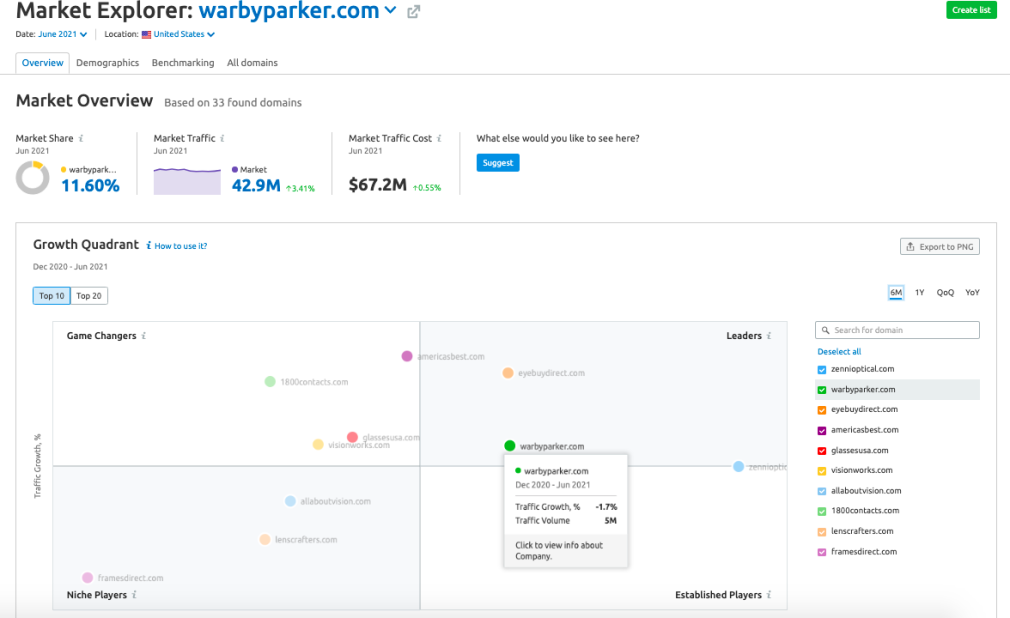
Online, Warby Parker's market share in the US in June 2021 was at 11.6% — this stat is based on the brand's June traffic count in relation to the overall market traffic.
- Establishing the key market players and their market growth dynamics
This 11.6% number does not reveal all that much if we don't consider market share patterns across the market.
The Growth Quadrant widget provides a full competitive landscape overview by pulling the key market players and returning stats on their growth over a selected time period.
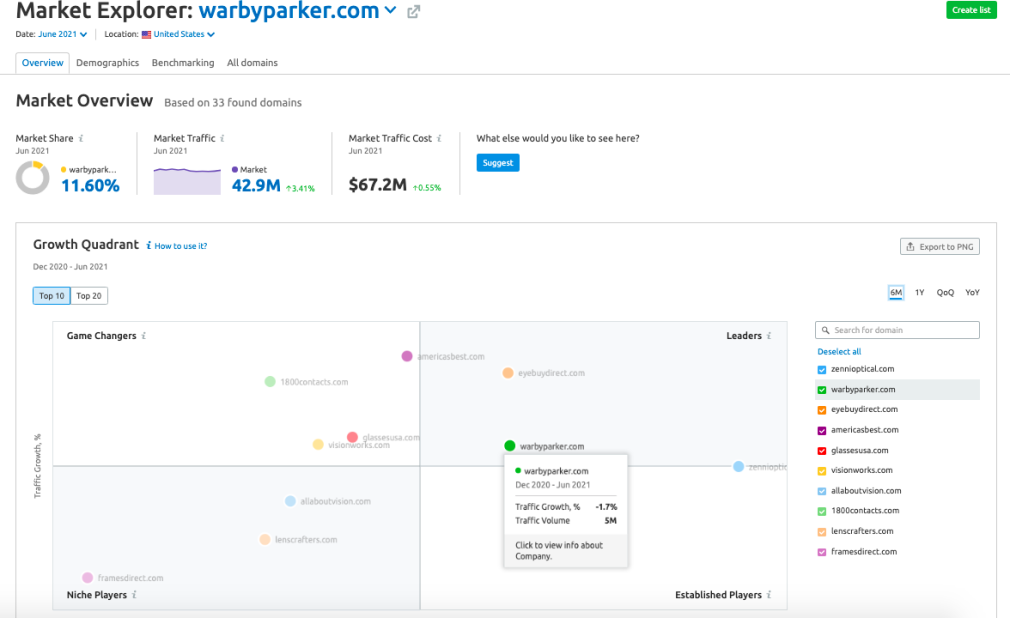
In this case, this market share number appears to put our brand as a market leader, a position you always want to maintain.
Within the Growth Quadrant, competitors are broken down into various segments that signify their position in the market:
- Niche players: These businesses have a smaller market share relative to the rest, and their growth rate is low compared to the market overall.
- Game changers: These companies have small traffic volumes, but their growth rate is higher than the market average. Startups or large companies entering new markets usually fall into this category.
- Leaders: These are businesses with a significant traffic volume and continuous growth.
- Established players: These are the companies with significant traffic volume, they reach a large portion of the market, but their growth rate isn't as high as the overall market. Established brands with name recognition make the most of this category.
For each competitor, the widget displays the key stats you have to be aware of — the estimated traffic volume and growth over the time period.
- Benchmarking your market share against the competition
If the Growth Quadrant returns absolute numbers (traffic, growth %), you also have to get into comparison mode and stack your market share up against competitors.
This is where the Share of Visits section comes into play.
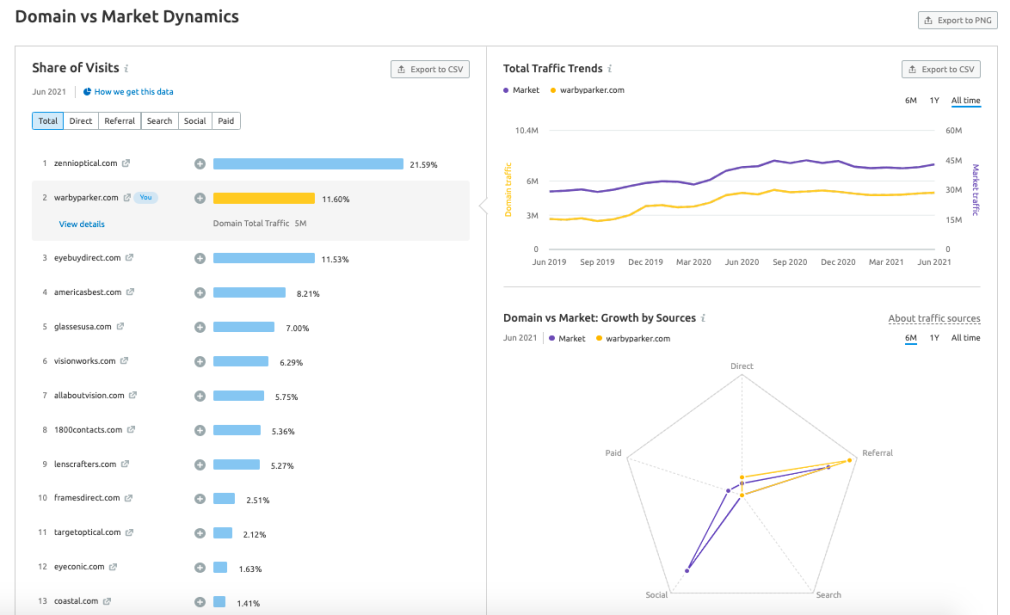
We can see that while Warby Parker is placed in the Leaders category, it has a much bigger competitor — Zennioptical — who has a 22% market share. And Eyebuydirect actually comes very close and poses a potential threat to Warby Parker by having an 11.53% market share.
Whether a market leader or a niche player, you need to keep innovating to maintain and/or expand your reach.
To make this happen, companies have to focus on growing their customer base, be it online or offline customers.
Here are some ways to increase market share:
1. Lowering Prices
Lower prices can be a quick and effective way to bring in more customers. Periodic discount campaigns that can compete with the competition can bring in new footfall.
You can either start with a lower pricing strategy overall — think how H&M's low costs turned it into the world's second-biggest apparel brand by market share — or simply offer seasonal discounts and other incentives (this post reveals how Black Friday affects traffic trends across industries).
2. Innovating
Introducing new features and products to your offerings is another way to grow your market share. Use existing data, customer feedback, and competitor analysis to make informed decisions about new product development that can boost your market share.
Besides, many of these new consumers will become loyal customers, decreasing your competitors' market share.
Innovation does not necessarily imply Tesla-like new model launches. You can even think of Starbucks' successful approach to embracing seasonal trends by offering Halloween/Xmas/etc.-inspired drinks and products.
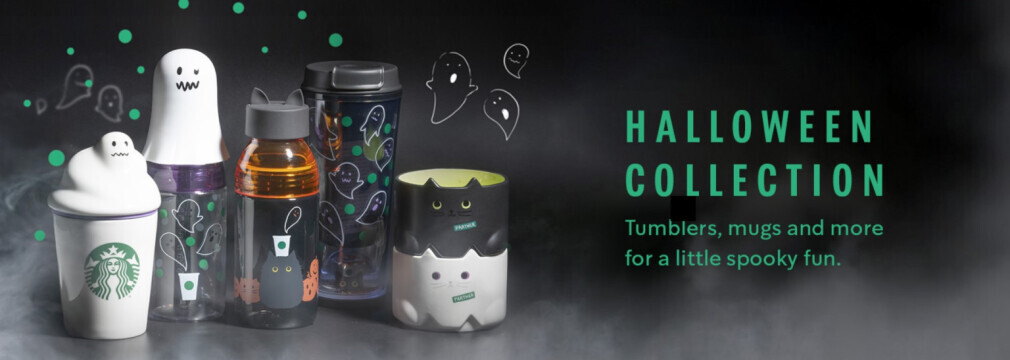
3. Focusing on Customer Retention
Strengthen customer relationships and build their loyalty to prevent customers from choosing a competitor if they come up with discounts or new offers.
Gaining market share via referrals and customer satisfaction can increase your company's revenue without increasing marketing expenses. After all, as an iPhone owner, you'll be much less likely to choose a shiny new Samsung over another iPhone since you can transfer all your phone data into a new iPhone in a click.
4. Finding New Demographics
Appealing to new demographics goes hand in hand with building new products and features. Watch out for market gaps your competitors might not be serving and see if there's an opportunity for you to serve this audience.
The best example is McDonald's' expanding healthy menu options that show how the brand tries to tackle the growing market of customers who prefer to eat healthy.
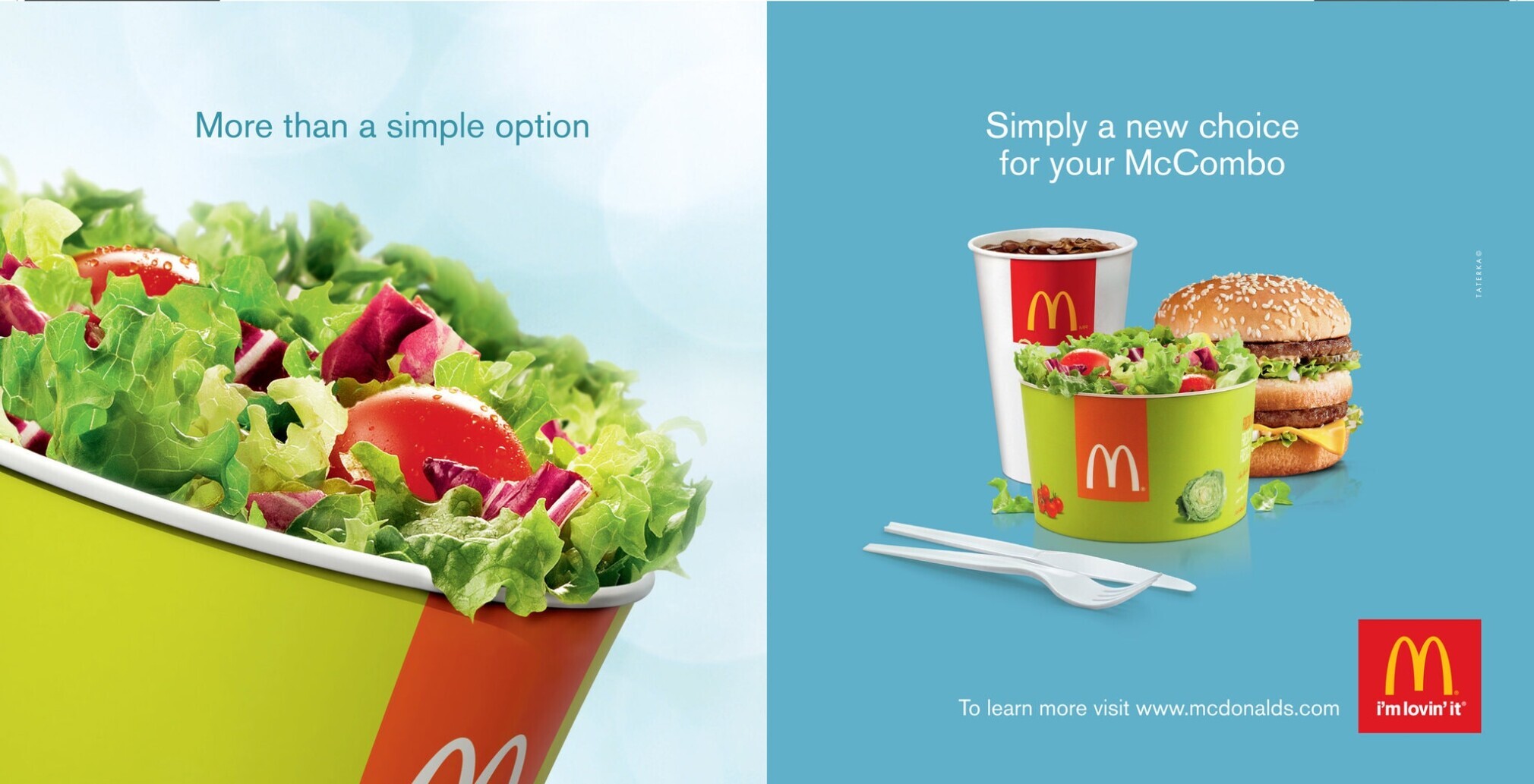
5. Acquiring Other Companies
Another way to increase market share is by acquiring competitors. Of course, this is a play for larger companies with enough capital to make this happen. A company taps into the acquired firm's existing customer base and reduces the number of companies fighting for the same market.
Facebook's acquisition of Instagram and WhatsApp is the most striking example here, as the company now owns the four most downloaded apps of the decade.
6. Increasing Brand Awareness
Efficient branding and marketing tactics can play a significant role in expanding your market share. The more customers know who you are, the more chances you have of capturing them. Building brand awareness can help you become a preferred brand in the industry to boost your market share.
The Dollar Shave Club ad that went viral (it has more than 27 million views) and opened up the brand to all imaginable audiences is already a classic example of an excellent brand awareness stunt.

7. Learn From Your Competitors
Using tools like our Market Explorer, you can better understand what the competition is doing to gain their market share.
By looking at the Traffic Generation Strategy and the Social Media Distribution Strategy, you can tell what acquisition channels your competitors are leveraging to reach a wider audience and evaluate each channel's efficiency.

Use this tool to learn from the market leaders and their successful tactics for ongoing growth. For more granular traffic insights, you can leverage the power of Traffic Analytics.
Market share stats can indicate how big the market is and how big a share you have relative to everyone else. So, essentially, this is a perfect way to analyze the market and see how much growth you can expect and achieve assuming you employ successful business and marketing tactics.
Yet there are certain things to keep in mind when analyzing your market share estimations:
- Find the right metrics
The classic sales-based approach to market share might not be relevant to all businesses. So, for businesses that rely on their online presence, it can be more helpful to look at market share from a traffic perspective.
- Brand mix can impact market share
Whenever companies add or take away brands, products, and services from a specific category, the market share changes. Looking at the Total Traffic Trends graph within Market Explorer can give you an idea of how your competitors' performance changes with these market shifts.
- Geography can impact your share
One of the most impactful variables in market share is geography. Drilling down into your regions can give you a new perspective on what's happening in that market.
For example, if you only operate within one area, comparing yourself to national players won't give you an accurate market overview or performance. And if you're a global brand, getting more granular country-level market share stats would reflect your market gaps and serve as an indicator for your future marketing efforts.
- Track your progress
Market share is not a metric you can track once and then rely on this number for years to come. Each quarter can come with growth or decline, so you need to keep a close eye on your and your competitors' market share stats. A lowering market share may expose a surge in competition, so use this information to analyze what competitors are doing to recognize strategies that you could implement as well.
Reveal your and competitors' online market share
with Market Explorer

Natalia Zhukova Natalia is a data-driven marketer focusing on market research and strategy development. Having a solid experience in digital marketing, Natalia has a passion in SEO, content marketing and multilingual website creation and optimization.
How To Find Market Share Percentage
Source: https://www.semrush.com/blog/how-to-calculate-market-share/
Posted by: millermince1938.blogspot.com

0 Response to "How To Find Market Share Percentage"
Post a Comment